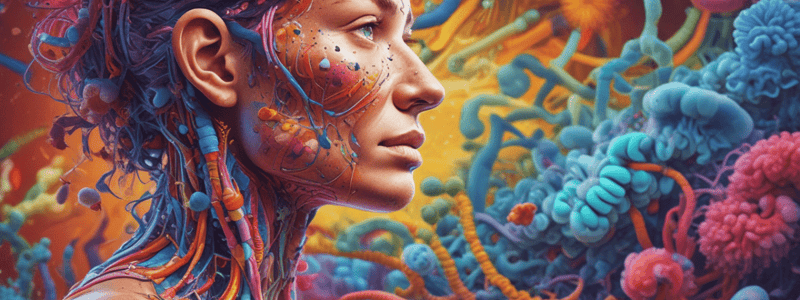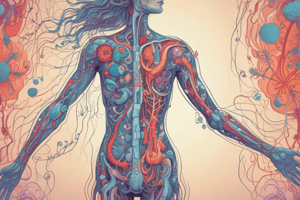Podcast
Questions and Answers
What term is used for ALL organisms present on and in human bodies, often causing no harm?
What term is used for ALL organisms present on and in human bodies, often causing no harm?
- Pathogenic microbiota
- Indigenous microbiota (correct)
- Transient microbiota
- Exotic microbiota
Which of the following body sites is considered a strictly sterile site, according to the text?
Which of the following body sites is considered a strictly sterile site, according to the text?
- Skin
- Lungs
- Mouth
- Blood (correct)
What is disrupted in dysbiosis, leading to harm to the host?
What is disrupted in dysbiosis, leading to harm to the host?
- Transient microbiota
- Pathogenic microbiota
- Exotic microbiota
- Indigenous microbiota (correct)
Which project focused on the role of the gut microbiome in training the immune system and modulating it to decrease autoimmune disease risk?
Which project focused on the role of the gut microbiome in training the immune system and modulating it to decrease autoimmune disease risk?
What is a common example of an opportunistic pathogen mentioned in the text?
What is a common example of an opportunistic pathogen mentioned in the text?
Where are Indigenous microbiota NOT found?
Where are Indigenous microbiota NOT found?
What is the term used to describe temporary residents on and inside our bodies?
What is the term used to describe temporary residents on and inside our bodies?
Which term describes a symbiotic relationship where two dissimilar organisms live together and both benefit?
Which term describes a symbiotic relationship where two dissimilar organisms live together and both benefit?
What does microbial ecology study the interactions of microbes with, apart from other microbes?
What does microbial ecology study the interactions of microbes with, apart from other microbes?
Which of the following is an example of a mutualistic symbiotic relationship?
Which of the following is an example of a mutualistic symbiotic relationship?
In commensalistic symbiosis, the relationship is beneficial to which of the organisms?
In commensalistic symbiosis, the relationship is beneficial to which of the organisms?
What term describes a symbiotic relationship where one organism benefits at the cost of another?
What term describes a symbiotic relationship where one organism benefits at the cost of another?
What is the role of lichens in a symbiotic relationship?
What is the role of lichens in a symbiotic relationship?
What do we call a symbiotic relationship that benefits neither of the organisms involved?
What do we call a symbiotic relationship that benefits neither of the organisms involved?
Which of the following is NOT a characteristic of the indigenous microbiota of the mouth?
Which of the following is NOT a characteristic of the indigenous microbiota of the mouth?
Which of the following bacteria is most often implicated in the formation of dental plaque?
Which of the following bacteria is most often implicated in the formation of dental plaque?
Which of the following is NOT a characteristic of the indigenous microbiota of the lower respiratory tract?
Which of the following is NOT a characteristic of the indigenous microbiota of the lower respiratory tract?
Which of the following is NOT a common organism found in the indigenous microbiota of the mouth?
Which of the following is NOT a common organism found in the indigenous microbiota of the mouth?
Which of the following is a characteristic of the indigenous microbiota of the gastrointestinal (GI) tract?
Which of the following is a characteristic of the indigenous microbiota of the gastrointestinal (GI) tract?
Which of the following is NOT a common organism found in the indigenous microbiota of the upper respiratory tract?
Which of the following is NOT a common organism found in the indigenous microbiota of the upper respiratory tract?
Which of the following is a key function of the indigenous microbiota in the mouth?
Which of the following is a key function of the indigenous microbiota in the mouth?
Which of the following is a characteristic of the indigenous microbiota of the skin?
Which of the following is a characteristic of the indigenous microbiota of the skin?
Which of the following anatomical locations on the skin is likely to have a higher concentration of bacteria?
Which of the following anatomical locations on the skin is likely to have a higher concentration of bacteria?
Which of the following factors does NOT influence the composition of the indigenous microbiota on the skin?
Which of the following factors does NOT influence the composition of the indigenous microbiota on the skin?
Which of the following is a common bacterial genus found on the skin?
Which of the following is a common bacterial genus found on the skin?
What is the significance of proper hand hygiene for healthcare workers?
What is the significance of proper hand hygiene for healthcare workers?
Which of the following statements about the indigenous microbiota of the eyes is correct?
Which of the following statements about the indigenous microbiota of the eyes is correct?
Which of the following statements about the indigenous microbiota of the ears is correct?
Which of the following statements about the indigenous microbiota of the ears is correct?
Which of the following is NOT a characteristic of the indigenous microbiota in the colon?
Which of the following is NOT a characteristic of the indigenous microbiota in the colon?
What is the approximate number of different microbial species found in the colon?
What is the approximate number of different microbial species found in the colon?
Which of the following organisms is NOT an example of the indigenous microbiota found in the colon?
Which of the following organisms is NOT an example of the indigenous microbiota found in the colon?
What is the exception to the statement that inhibitory components inhibit the growth of most organisms in the gastrointestinal tract?
What is the exception to the statement that inhibitory components inhibit the growth of most organisms in the gastrointestinal tract?
Where in the gastrointestinal tract are the majority of the indigenous microbiota found?
Where in the gastrointestinal tract are the majority of the indigenous microbiota found?
What is the primary function of bile in the duodenum?
What is the primary function of bile in the duodenum?
What is the relationship between E. coli and the indigenous microbiota of the colon?
What is the relationship between E. coli and the indigenous microbiota of the colon?
What is the primary function of the acidic pH in the stomach?
What is the primary function of the acidic pH in the stomach?
Which of the following is a characteristic of the members of the indigenous microbiota found in the colon?
Which of the following is a characteristic of the members of the indigenous microbiota found in the colon?
Flashcards
Indigenous microbiota
Indigenous microbiota
All organisms naturally present in and on the human body, harmless, including viruses, fungi, and bacteria.
Human Microbiome Project
Human Microbiome Project
A project focusing on the role of the gut microbiome in health, immune system training, and diseases like obesity and autoimmunity.
Gut Microbiome and Immune System
Gut Microbiome and Immune System
The gut microbiome plays a role in training and modulating the immune system, potentially reducing autoimmune disease risk.
Gut Microbiome and Obesity
Gut Microbiome and Obesity
An imbalance in the gut microbiome may be linked to obesity.
Signup and view all the flashcards
Microbiome Development in Babies
Microbiome Development in Babies
The study examines the difference in microbiome development in babies born by C-section.
Signup and view all the flashcards
Intestinal Microbiome and Neurodevelopment
Intestinal Microbiome and Neurodevelopment
The relationship between intestinal microbiomes and brain development is being studied.
Signup and view all the flashcards
Respiratory Tract Microbes
Respiratory Tract Microbes
The upper respiratory tract has many microbes (mostly harmless), but can harbor virulent pathogens.
Signup and view all the flashcards
Mouth Microbiota
Mouth Microbiota
The mouth has a high diversity of microbes, including bacteria, spirochetes, yeasts, and molds.
Signup and view all the flashcards
Streptococcus mutans
Streptococcus mutans
A bacterium often implicated in dental plaque formation.
Signup and view all the flashcards
GI Tract Microbiota
GI Tract Microbiota
The digestive tract has a large number and variety of bacteria, especially in the colon.
Signup and view all the flashcards
Colon Microbiota
Colon Microbiota
The colon has the richest variety of microbes, including many anaerobes.
Signup and view all the flashcards
E. coli
E. coli
A common bacterium in the colon, often harmless but can cause UTIs when present in the wrong place.
Signup and view all the flashcards
Microbial Ecology
Microbial Ecology
Study of how microbes interact with each other and their environment.
Signup and view all the flashcards
Symbiosis
Symbiosis
Relationship between two different organisms living together.
Signup and view all the flashcards
Mutualistic Symbiosis
Mutualistic Symbiosis
Both organisms benefit from the relationship, like gut bacteria.
Signup and view all the flashcards
Commensalistic Symbiosis
Commensalistic Symbiosis
One organism benefits, the other is neither harmed nor helped.
Signup and view all the flashcards
Skin Microbiota
Skin Microbiota
The skin has microbes that vary by location, influenced by pH, moisture, and other factors.
Signup and view all the flashcards
Eye Microbiota
Eye Microbiota
The eye has few microbes due to protective factors and antimicrobials in tears.
Signup and view all the flashcards
Ear Microbiota
Ear Microbiota
Outer ear contains microbes similar to skin, inner ear is generally sterile.
Signup and view all the flashcards
Sterile sites
Sterile sites
Areas of the human body that are normally free from microbes, e.g. blood, lymph, and spinal fluid
Signup and view all the flashcards
Human Microbiome
Human Microbiome
The complete collection of microbes living in and on our bodies.
Signup and view all the flashcards
Opportunistic Pathogens
Opportunistic Pathogens
Microorganisms that can cause disease under specific circumstances but normally are not.
Signup and view all the flashcards
Transient Microbes
Transient Microbes
Microbes sometimes found on human bodies but not part of the normal microbiome.
Signup and view all the flashcardsStudy Notes
Indigenous Microbiota
- Indigenous microbiota includes all organisms present on and in human bodies, causing no harm, and comprises viruses, fungi, bacteria.
- Specific regions have specific microbiomes, except for strictly sterile sites like blood, lymph, spinal fluid, and internal tissues.
Human Microbiome Project
- The Human Microbiome Project (2008) focuses on the role of the gut microbiome in training the immune system and modulating the immune system to decrease the risk of autoimmune diseases.
- The project also explores the imbalance of the gut microbiome and its link to obesity.
- Additionally, it examines trends in microbiome development in babies born by C-section and the relationship between intestinal microbiomes and neurodevelopment.
Characteristics of Body Sites
- Brainstorm: wet, dry, accessible to air, etc.
- Swimmer's ear: an example of indigenous microbiota in the ear.
Indigenous Microbiota - Respiratory Tract
- The respiratory tract is lined with mucous membranes and has two main areas: the upper respiratory tract (nasal passage and throat) and the lower respiratory tract (larynx, trachea, bronchi, and lungs).
- The upper respiratory tract has many microbes, mostly harmless, but can carry virulent pathogens and opportunistic pathogens.
- The lower respiratory tract is generally free of microbes due to the lungs and mucous membranes.
Indigenous Microbiota - Mouth
- Characteristics: gums, crevices between teeth, deep folds of the tonsil, moist, and lots of nutrients (e.g., food particles).
- Organisms: many species of bacteria, spirochetes, yeasts, molds, protozoa, and viruses.
- Common organisms: Gram-positive and gram-negative bacteria, spirochetes, yeasts, molds, protozoa, and viruses.
- Streptococcus mutans is the bacterium most often implicated in dental plaque formation.
- Other organisms include Actinomyces, Bacteroides, Corynebacterium, Lactobacillus, Neisseria, Staphylococcus, Streptococcus, and Veionella.
Indigenous Microbiota - GI
- Characteristics: long tube lined with mucus membranes, folds, and nutrients from food.
- Inhibitory components inhibit growth of most organisms.
- Acidic pH in the stomach, except for Helicobacter pylori.
- Bile in the duodenum.
- Organisms: mostly in the lower parts of the intestines like the jejunum and ileum.
- The colon contains the largest number and variety of microbes, with around 500-600 different species.
- Characteristics: anaerobic conditions.
- Organisms: mostly obligate, aerotolerant, and facultative anaerobes.
- Examples: Actinomyces, Bacteroides, Clostridium, Enterobacter, Enterococcus, Escherichia, Klebsiella, Lactobacillus, Parabacteroides, Proteus, Pseudomonas, Staphylococcus, Streptococcus.
- Many members of the colon microbiota are opportunists.
Indigenous Microbiota - GI (Colon)
- All humans have E. coli bacteria in their colon, which are opportunists, usually causing no problems, but can cause urinary tract infections (UTIs) when they gain access to the urinary bladder.
- There are also multiple strains of pathogenic E. coli that are not indigenous.
Microbial Ecology
- Definition: the systematic study of the interactions between organisms and the world around them.
- Relationships between organisms and their environment.
- Microbial Ecology: the interrelationship between microbes and the world around them.
- Study of their interactions with other microbes, the non-living world, and humans.
Symbiosis
- Definition: two dissimilar organisms (symbionts) living together.
- Mutualistic: both benefit (e.g., E. coli in the gut).
- Commensalistic: beneficial to only one (e.g., mites in hair follicles).
- Neutral: benefit neither.
- Parasitic: benefits one at the cost of another.
Indigenous Microbiota - Skin
- Characteristics: low pH, high levels of salt, lack of nutrients.
- Organisms: vary by site, mostly fungus and anaerobic bacteria living in deeper layers of skin.
- Composition varies by:
- Anatomic location
- pH
- Moisture
- Temperature
- Saltiness
- Toxic substances
- Think of skin on the body - a huge surface area.
- Repercussions for healthcare workers: proper hand hygiene is essential to remove most potentially harmful transient microbes and dead epithelial cells they may feed on.
Indigenous Microbiota - Eyes
- Characteristics: the eye is lubricated and protected by tears, mucus, sebum, etc. containing antimicrobials like lysozymes.
- Few microbes present.
Indigenous Microbiota - Ears
- Characteristics: outer ear and canal contain the same microbes as skin.
- Middle and inner ear are generally sterile.
- Microbes get carried into these areas when coughing or sneezing, leading to infection.
Studying That Suits You
Use AI to generate personalized quizzes and flashcards to suit your learning preferences.




